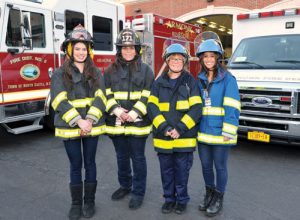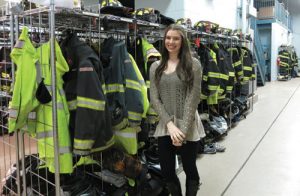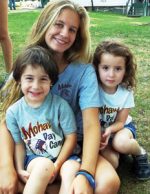
Four women graciously took time out from their busy schedules to talk about their roles as volunteers in Armonk. On a Monday night, the night set aside each week for the members of the Armonk Volunteer Fire Department to meet for training, cleaning equipment, restocking the vehicles, and sharing a meal, these inspiring women spoke humbly of their varied, yet similar, roles in the department. As they spoke, each one began to learn more about the others, encouraging each other along the way. From a high school junior to a mother with three children, they are united in their common goal: helping people.
The Armonk FD is one of only nine departments in the county with a combined fire and ambulance service. All the others (some volunteer, some career) have separate departments. As one of the women put it, “we work more efficiently as a team when we have to work together.”
Luci Labriola-Cuffe is currently the Chief of Fire Training at the Westchester County Department of Emergency Services, where all 58 fire departments in the county go for training. She volunteers both as a firefighter and an emergency medical technician in Armonk, and has the distinction of having served as Armonk’s first and only female Chief, from 2011 to 2013.
Beginning as an officer in the department and continuing for eight years, Labriola-Cuffe then moved through the ranks, first as an assistant chief for four years, then two years as Chief. Her husband is a police officer in North Castle. The two met while responding to the same calls.
Inspiration to serve? As a child, Labriola-Cuffe’s father suffered with a recurring and serious illness, which necessitated frequent visits to their home by emergency personnel. She was deeply touched by the great work of the EMT’s who repeatedly came to the house and cared for him. “I realized at a young age that I wanted to help people.” During her school years, she became a lifeguard, and continued through college. After graduating with a degree in cardiac rehabilitation and working in the field for a few years, she shifted gears and became a firefighter, the first in her family to join the fire department.
Most memorable call? Helping to deliver a baby in the home of an Armonk resident during October of 2014, alongside her husband. “It was the most exciting call,” she mused, noting that while the mom did all of the work, she was able to offer assistance. Of all the calls involving fires, accidents, and injuries, this one stood out in a good way. “It was thrilling,” she recalled with a smile.
Advice for anyone thinking about joining the department? “You CAN. There is nothing more rewarding than working together.” Labriola-Cuffe spoke of the sense of family, and of teamwork, amongst the fire and emergency medical teams. “You do get something out of this. This is a very rewarding job, and you are very fulfilled knowing you are helping other people.” She also spoke with empathy of the need to be there for the people whose calls she responds to. “They are having their worst day,” she realizes.

Lexi Draper is a high school junior and a member of the Junior Corps, which is for young men and women from the age of 16 through 18. She initially wanted to join the ambulance corps, like her father, but is not yet old enough. Chief Carlos Cano offered her the option of joining the fire department as a junior firefighter, which she gladly accepted. The only girl in a class of about 23, Draper expressed gratitude that the boys have definitely included her as part of the team.
First call? There was a recent call regarding a mattress fire, which had ignited from a car on I-684. Though it was a school night, Draper was permitted to go on the call. (The Junior Corps has a weeknight curfew of 9 p.m. and a weekend time limit of 11 p.m., so as not to take away time from school and studies). Draper proudly described how she, while supervised by experienced members of the department, was put in charge of the nozzle at the end of the hose, an instrumental and rewarding moment for her. “Every call has one goal–putting out fire.”
Role models? Draper has been inspired by both of her parents. Her father serves as a member of the ambulance corps, and her mother is a nurse. Draper’s interest in science and medicine is a perfect fit.
Biggest challenge? Setting aside time for all her activities, including classes, homework, fire department training, and babysitting. Balancing her time becomes crucial.
Advice for peers? “Don’t be afraid to be the only girl to do what you want to do.”
A wife and mother of three boys, Elissa Weinhoff has always had a passion for medicine. First a pre-med student, and then a middle school science teacher, Weinhoff is currently in training as an Emergency Medical Technician. She is taking the extensive training course as well as riding along on the ambulance with EMT’s. Weinhoff plans to take the New York State exam on May 21. She will be on probation until she meets all of the requirements, and hopes to become a full fledged member of the Armonk Emergency Medical Services by this coming September.
Biggest challenge? Taking the required 200 hour course, which consists of a four hour class, two times a week. She travels to New Rochelle for this six month training. “It feels like you’re never going to know everything you need to know.”
Thoughts on volunteering? “This whole operation is unbelievable. This is a team, very supportive, patient–it really is like a family.”
Sue Macellaro has been a member of the Ambulance Corps for 11 years, and is now the Captain. She had been going through a job change years ago, and was not sure what she wanted to do. She even considered becoming a volunteer “candy striper” at a hospital. Encouraged by her husband, she chose to volunteer with the fire department in Armonk as an EMT.
Role model? Her father and brother were both firemen, and inspired her to help people in some capacity.
Most memorable call? Macellaro recalled two severe injuries. One was a young boy accidentally hit by a car. When she arrived at the scene, she found him awake, purple, and desperately gasping for breath. “I talked to him, and kept him awake,” she recounted, trying to keep him as calm as possible. The child fully recovered, but the accident stayed with her.
The second was a “burn call” for a man pinned behind the steering wheel of his car. The car caught on fire after a collision, and the man, a Polish citizen in the country for a visit, was severely burned. He had to be cut out of the car and he, too, was awake. “It was very overwhelming,” Macellaro recalled. “I couldn’t get the smell of burning hair out of my nose.” Visibly touched by the memory, she spoke of visiting the man in the burn unit of the hospital, trying to comfort him before he recovered enough to return home to his family in Poland. Macellaro also spoke of the peer support teams that assist the fire fighters and emergency medical technicians in times of tragedy such as this.
Range of experiences? “We see the gamut.” Serving the airport (HPN, which stands for Harrison Portchester North Castle), calls can range from plane crashes to the needs of older residents, now living at home longer and requiring the help of the ambulance corps more frequently.
In the candid discussion that followed, the women addressed the need for more volunteers, as well as challenges they all face as part of their job.
“It is getting tough,” Macellaro said matter-of-factly. “Many people work. Volunteers are a tough commodity these days.”
Labriola-Cuffe pointed out that perhaps the greatest need for volunteers is during the day, precisely when moms with children in school could be of assistance. Many of the firefighters and EMTs work or attend school during the day, and are less able to respond to calls. “Once you get through training (which is free and in-house for volunteers), you give what you can.”
“I wasn’t sure if I could do it, and then it suddenly took off,” said Macellaro, who added that education continues all the time.
As far as safety goes, whatever the emergency, the safety of the membership is the first priority. “Scene safety,” as Labriola-Cuffe referred to it, is what enables the volunteers to be able to go out on calls to help others.
Other aspects of volunteering? “Keep your mind open,” advised Labriola-Cuffe. At times, what a call starts out as and what you might actually encounter are two different things. “Be able to get back out there.” There are difficult situations to process, which may have lasting effects. However, there is an abundance of support, from the team as a whole as well as special peer support groups when needed.
For more information and ways to help, please visit www.armonkfd.com
Eileen Gallagher is a freelance writer and frequent contributor to Inside Chappaqua and Inside Armonk magazines. Residing in Chappaqua with her husband and sons, she respects and appreciates the tireless work of all who dedicate themselves to saving lives and keeping their communities safe.




